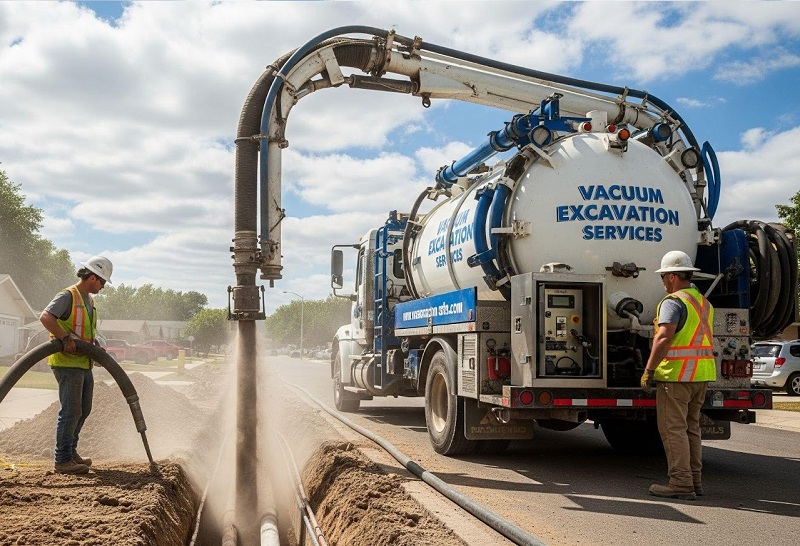In construction, utility maintenance, as well as in civil engineering projects, the demand for precision and safety has become higher than ever. Traditional digging methods-like mechanical excavation, are slow, hazardous, and highly destructive to the surrounding environment. That is where vacuum excavation comes into play.
Advanced suction technology coupled with pressurised air or water allows you, by way of vacuum excavation, to expose underground utilities, pipes, and cables with remarkable precision while minimising the risk of their accidental damage.
For the contractor, municipal worker, and utility operator, selecting vacuum excavation goes beyond the modern alternative; it is a strategic choice to enhance workflow efficiency, reduce the costs associated with site damage, and, importantly, make the worksite a safer place.
This article will discuss how vacuum excavation enhances project efficiency, protects infrastructure, and why it is favoured over other methods in many industries.
What Is Vacuum Excavation?
Vacuum excavation is a non-destructive digging technique that uses either air or water to loosen soil and a powerful vacuum system to remove the debris. Unlike traditional mechanical digging, which relies on shovels or heavy machinery, vacuum excavation allows you to precisely target an area without affecting nearby underground structures.
Methods of Vacuum Excavation
- Air Excavation – Uses compressed air to break up the soil, which is then vacuumed into a containment tank. This method is particularly useful for delicate sites with high-risk utilities.
- Hydro Excavation -Utilises pressurised water to loosen soil before it is suctioned into the tank. This method is faster in compacted soil and is excellent for trenching or potholing around underground assets.
By understanding these methods, you can select the right approach based on soil type, site conditions, and the complexity of underground utilities.
How Vacuum Excavation Improves Efficiency
Time and efficiency are critical in construction and maintenance projects.
Here’s how vacuum excavation streamlines your work:
Faster Project Completion
Traditional excavation methods using large and slow machinery often take time and require much manual labour. Whereas vacuum excavation is a much faster and more efficient process, needing little labour and clean up afterwards.
Reduced Labour Requirements
You require fewer labourers to operate a vacuum excavator, and there is no need for manual digging. Thus, it reduces labour costs, and your workforce can focus on other tasks rather than digging.
Accurate Excavation Reduces Rework
Vacuum excavators are extremely precise compared to traditional excavators. They accurately target even the smallest areas and reduce the guesswork of digging.
Vacuum Excavation Minimises Site
One of the most significant advantages of vacuum excavation is its ability to protect both the surrounding environment and existing infrastructure.
Protecting Underground Utilities
Striking a gas line, water pipe, or electrical cable can be catastrophic. Vacuum excavation’s precise approach allows you to expose utilities safely, reducing the risk of damage and subsequent service interruptions. You can work confidently, knowing the risk of costly utility strikes is greatly minimised
Preserving Landscaping and Infrastructure
Whether you are working in urban areas, residential gardens, or commercial sites, vacuum excavation reduces collateral damage. Traditional mechanical excavation can disturb surfaces, compromise tree roots, and disrupt pavements or driveways. Vacuum methods allow you to excavate with minimal surface impact, keeping the surrounding site intact.
Environmentally Friendly
Vacuum excavation is not only safer for infrastructure but also better for the environment. Hydro excavation uses water sparingly, and air excavation doesn’t require heavy machinery that emits pollutants. By reducing soil displacement and minimising damage, your projects maintain ecological balance while staying compliant with environmental regulations.
Vacuum Excavation is Versatile
Vacuum excavation is ideal for residential and commercial projects with various applications.
- Utility Maintenance – Quickly locate and expose gas, water, and electricity lines for repairs or inspections.
- Construction Projects – Excavate safely around critical infrastructure without disturbing the surrounding site.
- Telecommunications – Install or repair fibre-optic cables and underground conduits with minimal disruption.
- Municipal Works – Maintain sewer lines, storm drains, and other municipal infrastructure efficiently and safely.
This versatility ensures that, whether you are a small contractor or a large city utility operator, vacuum excavation can adapt to your project needs.
Safety Benefits of Vacuum Excavation
Because vacuum excavation is a non-destructive digging method, it holds many safety benefits.
- There is a reduced risk of accidental utility strikes.
- There is less strain on workers because the excavator does most of the work.
- It is a precise and compliant method of excavation according to safety regulations.
- There is less risk of injury or property damage.
Conclusion
Vacuum excavation blends precision, efficiency, and safety, creating a whole new way to conduct excavations. This technique enables you to undertake jobs with renewed confidence and professionalism through reductions in labour requirements, accelerated project timelines, and minimised damage to underground utilities and the surrounding site.
Whether you’re working in urban construction, utility maintenance, or sensitive landscaping areas, incorporating vacuum excavation means your job will be safer, quicker, and more economical. In this modern approach, you protect not only infrastructure and the environment but also raise your overall project efficiency.
For any excavation where precision is a factor, vacuum excavation is the intelligent, forward-thinking way to go.






